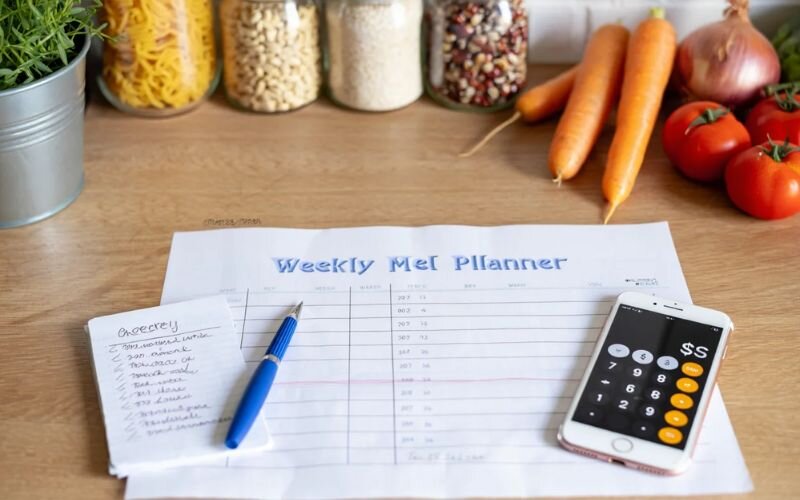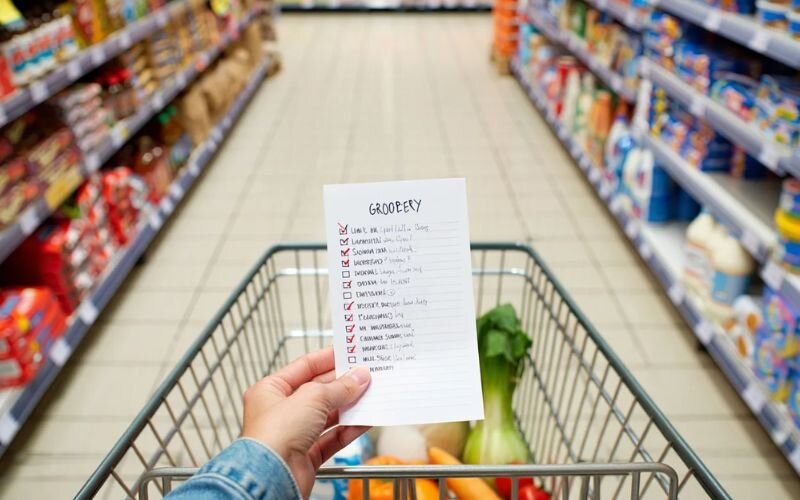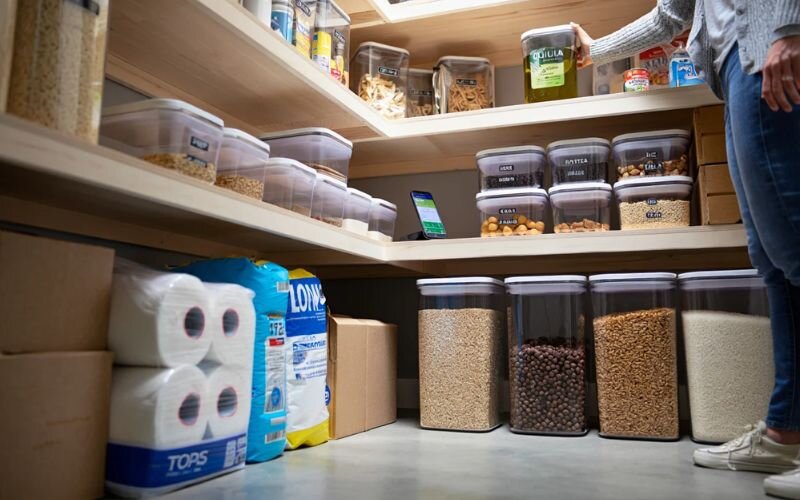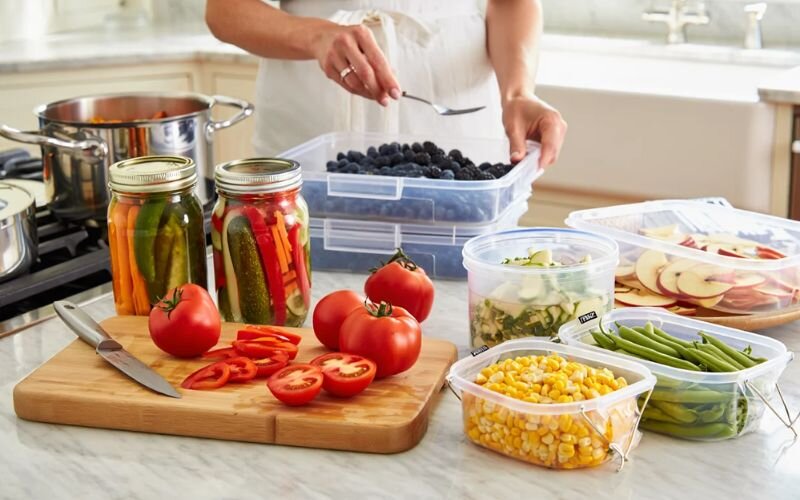Grocery shopping on a budget isn’t just about clipping coupons; it’s a skill refined through real-world trial and error. As someone who once overspent nearly 30% of my monthly budget on food, I’ve learned firsthand how small, consistent changes can lead to big savings.
From meal planning failures to finally mastering bulk-buying strategies, these 15 grocery budget tips are drawn from experience, not theory. Whether you’re feeding a family or just trying to stay on top of rising costs, each tip is practical, tested, and designed to help you shop smarter without compromising nutrition or taste.
1. Create a meal plan to save time and money
Planning your meals in advance is one of the most effective grocery budget tips to reduce food waste, save money, and avoid last-minute takeout. By knowing exactly what you’ll cook each day, you can shop more efficiently, use ingredients across multiple meals, and take advantage of bulk buys without letting food spoil.

For example, here’s a simple 5-day budget-friendly meal plan I used one week:
- Monday: Stir-fried vegetables with tofu and rice
- Tuesday: Chicken noodle soup using leftover veggies and shredded chicken
- Wednesday: Egg fried rice with frozen peas and carrots
- Thursday: Lentil curry with flatbread (made from pantry staples)
- Friday: Tuna salad sandwiches and oven-baked sweet potatoes
I based the entire week on versatile, low-cost staples like rice, eggs, and canned goods, while rotating vegetables to prevent waste. By reusing ingredients, for example, the same carrots and cabbage were used in both the stir-fry and the fried rice, I cut down significantly on waste and excess spending.
The result? That first week, my grocery bill dropped to around $35. It wasn’t a perfect system, but the real win was the lack of stress. For the first time in ages, I didn’t have that 5 PM panic of “what’s for dinner?” which usually ended with an expensive takeout order. That feeling alone was worth more than the $20 I saved.
2. Shop with a list and stick to it
A shopping list is your best defense against overspending and impulse purchases at the grocery store. Without a list, it’s easy to get distracted by eye-catching displays or tempting deals on items you don’t need, which can inflate your grocery bill.
Research from SNAP-Ed programs emphasizes that sticking to a list helps you focus on planned meals and avoid unnecessary purchases. A list also saves time by keeping you on track, preventing aimless wandering through aisles designed to encourage spending.

To maximize efficiency:
- Organize by store layout: Arrange your list according to the store’s aisles (e.g., produce, dairy, pantry staples) to streamline your shopping trip. Many stores offer online maps or apps to help with this.
- Categorize by meal type: Group ingredients by meal (e.g., breakfast, lunch, dinner) to ensure you don’t miss anything for your planned recipes.
- Use digital tools: Apps like AnyList or Out of Milk allow you to create and sync lists with family members, ensuring everyone knows what’s needed.
- Avoid shopping hungry: Eating before you shop reduces the urge to buy snacks or convenience foods impulsively.
Honestly, a well-planned list is your best defense against the store’s marketing magic. It keeps you focused, saves you from yourself, and ensures your budget stays intact.
3. Purchase store-brand or generic products
Many store-brand products are produced in the same facilities as their name-brand counterparts, offering nearly identical ingredients and nutritional value at a lower price.
For example, a store-brand can of black beans or pasta can cost 20-50% less than a name brand, adding up to significant savings over time. Bankrate notes that saving just $2-3 per item on 20 products can make a noticeable difference in your budget.
To make the most of store brands:
- Compare ingredient lists: Check labels to ensure the generic version meets your quality standards, especially for items like canned goods, cereals, or dairy.
- Test gradually: If you’re hesitant, try store brands for staples like rice, flour, or spices before switching to more complex items like snacks or sauces.
- Look beyond stigma: Store brands have improved in quality, and many, like Trader Joe’s or Aldi’s private labels, are highly rated for taste and value.
Nailing your bulk-buying strategy means you’re not just stocking your pantry, you’re actively lowering your long-term grocery bill. Just remember: strategy is key, or you’ll end up with a ten-pound bag of expired quinoa.
See more related articles:
4. Purchase in bulk strategically
Items like grains (rice, oats), pasta, canned goods, and dried beans are ideal for bulk purchases because they have long shelf lives and are often cheaper per unit when bought in larger quantities.
For example, purchasing a 10-pound bag of rice at Costco can cost less per pound than a smaller bag at a regular grocery store. However, strategic bulk buying requires careful planning to avoid waste, especially with perishable items.

Tips for effective bulk buying:
- Focus on staples: Prioritize items you use frequently, such as flour, sugar, or frozen vegetables, to ensure they won’t go to waste.
- Check unit prices: Always compare the cost per unit (e.g., per ounce or pound) to confirm bulk options are truly cheaper.
- Avoid perishable overbuying: Be cautious with fresh produce or dairy unless you can freeze or use them quickly. For instance, buy extra chicken on sale and freeze it for later use.
- Store properly: Invest in airtight containers to keep bulk items fresh and organized, extending their shelf life.
By buying in bulk strategically, you can lower your grocery bill while keeping your pantry well-stocked.
5. Focus on seasonal produce
It’s a well-known fact in the nutrition world, and experts at places like the Mayo Clinic often highlight this, that in-season produce is at its peak in both flavor and nutritional value.
Shopping at farmers’ markets or joining a Community Supported Agriculture (CSA) program can further reduce costs by connecting you directly with local, seasonal produce.
Examples of seasonal produce (U.S.-based, varies by region):
- Spring (March-May): Asparagus, strawberries, peas, spinach, lettuce.
- Summer (June-August): Tomatoes, zucchini, berries, peaches, corn.
- Fall (September-November): Apples, pumpkins, sweet potatoes, Brussels sprouts.
- Winter (December-February): Citrus fruits, kale, winter squash, carrots.
Tips for maximizing savings:
- Plan meals around seasonal items: If tomatoes are in season, incorporate them into salads, sauces, or soups.
- Preserve for later: Freeze or can excess seasonal produce to enjoy year-round at a lower cost.
- Check local guides: Use resources like the USDA’s seasonal produce guide or local farmers’ market websites to identify what’s in season in your area.
Leaning into seasonal produce doesn’t just keep your budget in check; it makes your food taste incredible. It’s a simple shift that elevates your meals from “just okay” to “wow, what’s in this?”
6. Compare prices across stores
Prices for the same items can vary significantly between supermarkets, discount stores, and wholesale clubs, so taking the time to research can lead to substantial savings.
To make informed decisions:
- Use store flyers: Check weekly sales flyers, available in-store, in newspapers, or on store websites and apps, to identify discounts on items you need. For instance, if chicken is on sale at one store and canned goods are cheaper at another, plan your shopping route accordingly.
- Leverage price comparison apps: Apps like Flipp, Basket, or Price Cruncher allow you to compare prices across multiple stores in your area, saving time and ensuring you get the best deal.
- Visit discount stores: Explore chains like WinCo Foods or Dollar General for lower prices on pantry staples and non-perishable items.
- Consider wholesale clubs: If you have a membership at Costco or Sam’s Club, bulk purchases can save money on items like grains or meat, but only if you can use them before they expire.
- Shop locally: Farmers’ markets or local grocers may offer competitive prices on fresh produce, especially for seasonal items, and can be a great alternative to chain stores.
By dedicating a little time to research, you can strategically shop at the stores offering the best value for your grocery list, keeping your budget in check.
7. Use coupons and loyalty programs
Most grocery stores provide free loyalty programs that unlock exclusive deals, personalized offers, and reward points that can be redeemed for future purchases.
As someone who regularly shops at major grocery chains like Kroger and Safeway, I’ve learned that signing up for loyalty programs unlocks exclusive deals, personalized offers, and points redeemable for future purchases.
For instance, I once overlooked my accumulated points at a local supermarket but decided to check my account before a big shopping trip. By redeeming those points, I saved $15 on a $75 bill—a 20% discount I wouldn’t have noticed without checking.
According to industry insights from sources like Forbes, loyalty programs can save shoppers up to 10-20% on regular purchases when used consistently. However, the key is to use coupons and programs strategically to avoid falling for deals on items you don’t need.

Tips for maximizing savings:
- Sign up for loyalty programs: Join programs at your preferred stores to access member-only discounts. Many stores, like Publix or Target, allow you to link your account to their app for seamless savings at checkout.
- Use digital coupons: Check store apps or websites like Coupons.com for digital coupons that can be loaded onto your loyalty card. For example, clipping a coupon for $1 off cereal you already planned to buy is a smart way to save.
- Combine offers: Stack coupons with sales or loyalty discounts for maximum savings, but ensure the item is something on your list to avoid overspending.
- Avoid unnecessary purchases: Only use coupons for items you regularly use or need for your meal plan. A deal isn’t a deal if it leads to buying something you won’t use before it expires.
- Check expiration dates: Ensure coupons align with your shopping schedule, as some have short redemption windows.
8. Shop your pantry first
Before heading to the grocery store, take a moment to inventory your pantry, fridge, and freezer to make the most of the ingredients you already have. Think about it: how often do you find a long-lost can of beans in the back of your pantry? It happens to all of us.

In fact, studies from organizations like the USDA estimate that American households waste a shocking amount of food, some figures suggest as much as 30% of the food supply.
9. Pay with cash or rewards cards
Paying with cash is a powerful way to stick to your grocery budget by physically limiting how much you can spend. Unlike credit or debit cards, which can tempt you to overspend, cash forces you to prioritize and stay within your planned amount.

For example, if you bring $50 to the store, you’ll be more mindful to avoid avoiding extras like snacks or specialty items. Studies from financial experts like Dave Ramsey suggest that using cash can reduce impulse purchases by up to 20% because it makes spending feel more tangible.
Alternatively, grocery rewards cards offer another way to save by earning points or discounts on future purchases, adding long-term value to your shopping.
10. Leverage cash-back and rebate apps
Cash-back and rebate apps are game-changers for saving money on groceries, offering refunds or rewards for purchasing specific products. These apps, such as Ibotta, Rakuten, or Fetch Rewards, allow you to earn cash back by scanning receipts or linking your loyalty accounts, with savings ranging from a few cents to several dollars per item.
While it might seem like small change, the savings add up. Reports from couponing sites often show that consistent users can save anywhere from $50 to over $100 a year, depending on their habits.
Personally, my mom started using Ibotta last year after I showed her how it works. She was skeptical at first, but after scanning receipts for everyday items like milk, bread, and bananas, she earned $25 in cash back over three months, which she redeemed via PayPal to cover part of our next grocery trip. That small win convinced her to check the app regularly before shopping.
Read more:
11. Shop at the right time
Timing your grocery shopping can lead to better deals, fresher produce, and a more efficient experience. Shopping during less busy times or when stores restock ensures access to high-quality items and markdowns, which can significantly reduce your grocery bill.
For example, many stores restock produce mid-morning or mark down items like meat or bakery goods near closing time to clear inventory.
Normally, I shop at my local supermarket on Saturday mornings around 10 a.m., but one evening, I had to go at 8 p.m. because of a busy day. To my surprise, I found chicken breasts marked down 40% because they were nearing their sell-by date.
I bought two packs for $6 instead of $10, froze them, and saved $4 that week, a deal I wouldn’t have caught during my usual time.
12. Make homemade versions of packaged foods
Preparing homemade versions of commonly packaged foods is a great way to save money and control what goes into your meals. Instead of buying bottled tomato sauce, you can cook it from fresh tomatoes, garlic, onions, and spices already in your pantry.

I personally started making my own granola and salad dressings. It wasn’t just about saving a few bucks. I was getting tired of reading the crazy-long ingredient lists on the bottles at the store. My homemade versions aren’t always as pretty, but I know exactly what’s in them, and the process has become a surprisingly calming Sunday ritual.
13. Freeze or preserve excess produce
Don’t let leftover fruits or vegetables go to waste. Freezing them properly can extend their shelf life and prevent unnecessary spending. For instance, ripe bananas can be sliced and frozen for smoothies.

You can also cook larger batches of meals like stews or sauces and freeze portions for future busy days, saving both time and money.
14. Coordinate with roommates or family
If you live with roommates or family, collaborating on food shopping and meal prep can lead to significant savings.
Strategies for coordinating effectively:
- Split bulk buys: Agree to purchase large quantities of staples like pasta, oil, or frozen vegetables and divide them equally. This works well for non-perishables with long shelf lives.
- Share meal prep: Take turns cooking or prepping ingredients for shared meals. For instance, one roommate can chop vegetables while another prepares a protein, cutting prep time in half.
- Plan group meals: Coordinate weekly menus to avoid duplicate purchases. My roommate and I plan two shared dinners a week, like stir-fry or tacos, which reduces our individual grocery costs by about $10 weekly.
- Use shared lists: Create a shared shopping list on apps like AnyList to ensure everyone knows what’s needed and avoid overbuying.
- Divide store trips: Assign different stores to each person based on deals, like one hitting a discount store for produce and another visiting a wholesale club for bulk items.
I learned this the hard way after my roommates and I once ended up with three giant tubs of hummus in the fridge because none of us communicated. Once we started a shared list and planned a couple of “family dinners” a week, our bills went down, and the kitchen became a much friendlier place.
Plus, I learned how to make Maria’s killer stir-fry, a skill I wouldn’t trade for anything.
Maybe you should know: Budgeting for couples: 8 smart ways to manage money together
15. Avoid falling for sales traps
Just because something is on sale doesn’t mean it’s a good deal. Retailers use tactics like limited-time offers to pressure you into spending more. Be mindful and stick to your list. A “buy one, get one free” offer might be tempting, but if you won’t use the second item, you’re wasting money.

Remember, a deal is only a deal if you were going to buy it anyway. Otherwise, it’s just clever marketing.
16. Frequently asked questions (FAQs)
The 5-4-3-2-1 rule is a simple and structured approach to grocery shopping that helps ensure nutritional balance while keeping your list focused. It suggests buying 5 types of vegetables, 4 protein sources, 3 fruits, 2 grain-based items (like rice, bread, or pasta), and 1 treat or snack.
The best way to budget for groceries is to start with a meal plan and build your shopping list around it. This ensures you only buy what you need and reduces waste. Using grocery apps to track spending and compare prices is also helpful.
Stores like Aldi, Walmart, and Lidl are known for low prices. However, the cheapest option often depends on your local area. Compare weekly flyers or use price comparison apps to find the best deals near you.
17. Conclusion
Mastering grocery budget tips can transform the way you shop, helping you save money, reduce waste, and enjoy nutritious meals without breaking the bank. By implementing the strategies above, like meal planning, shopping with a list, and leveraging cash-back apps, you can take control of your grocery spending while maintaining quality and variety in your diet.
For more actionable advice on managing your finances and optimizing your spending, explore additional articles in the Strategies section and Budgeting Strategies of H2T Funding. Keep applying these tips for grocery shopping on a budget, and you’ll be well on your way to smarter, more cost-effective shopping.





